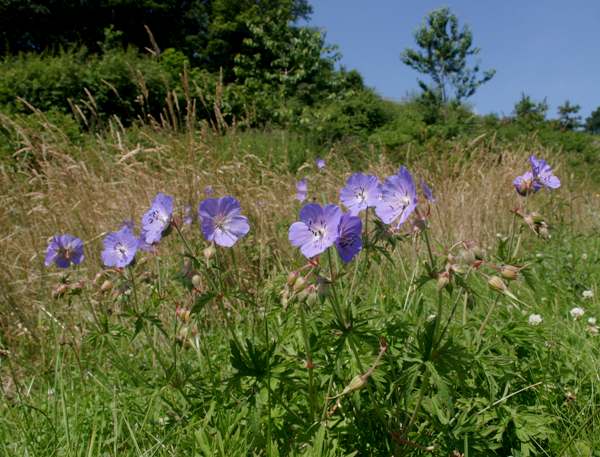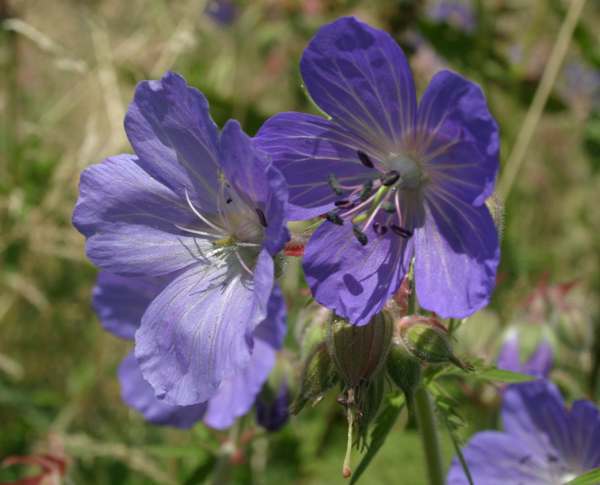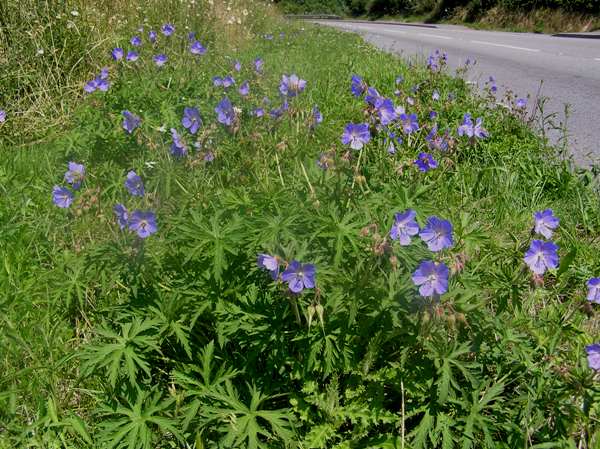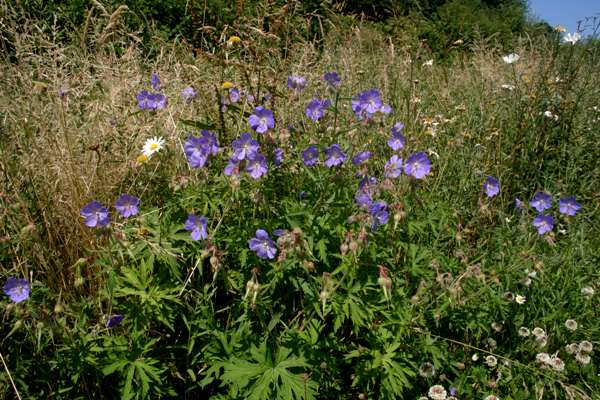Trees Birds Mammals Fish Amphibians Reptiles
Wild Algarve
Bookshop
Geranium pratense - Meadow Crane's-bill
Phylum: Magnoliophyta - Class: Equisetopsida - Order: Geraniales - Family: Geraniaceae

One of the loveliest of the wildflowers of Britain and Ireland, Geranium pratense flowers are usually violet-blue, and sometimes a very deep blue on chalky soil,but pink and even pure white specimens are also seen occasionally.
Description
Geranium pratense is a clump-forming perennial growing to a height of typically half a metre and occasionally more. (Near towns, cultivars from gardens are more common than wild plants.)

Meadow Crane's-bill plants have a basal rosette of opposite long-stalked leaves above which arise several blunt-edged hairy stems branch occasionally and have short-stalked or stalkless 7- to 9-lobed palmate leaves that are deeply-cut, sharply-toothed and have pointed tips. As with other wild geraniums the stems tend to redden towards the end of the flowering season.
Individual flowers are 3 to 4cm across with five unnotched petals and five short pointed hairy sepals. Each flower has ten stamens and a pistil of five fused carpels. Borne usually in pairs on axilliary flower stalks, the flowers produce five-sectioned seed capsules with beak-like tips.
Distribution
Meadow Crane's-bill is found in greatest abundance in the east of and south of England, although it can also be found right in the north of Scotland.

In Scandinavia, where this flower is widespread and common, it is called the Mid-summer Flower (Midsommar Blomster) because it can always be relied upon to be flowering in time for the Mid-summer celebrations - a far more important festival in those cold countries than Christmas!
Habitat
On the edges of permanent pastures, beside hedgerows and on roadside verges are the kinds of places where Meadow Crane's-bill has escaped chemical herbicides and still thrives. This chalk-loving wildflower is also found on scrubby downland.
Blooming Times
In Britain and Ireland Meadow Cranesbill flowers from June until September; if they have been cut down by mowers in June, plants on roadsides often produce a second flush of flowers in September.

Uses
With a stringent, styptic and antiseptic medical properties, Meadow Crane's-bill and its close relatives were used to relieve a range of diseases including cholera, diarrhoea and dysentery; to treat nosebleeds, ulcers and haemorrhoids and to staunch bleeding wounds. (We strongly advise against eating or using as medicines any plants without first obtaining qualified professional advice.)
Etymology
Geranium, the genus name, comes from the Greek noun geranos, meaning Crane (birds of the group of species known as the Gruidae). It is a reference to the beak-like fruit (seed capsule) which is reminiscent of the long beak of a Crane. The specific epithet pratense means of the meadow.
Similar Species
Bloody Crane's-bill Geranium sanguineum produces bright red flowers otherwise similar to those of Meadow Cranesbill.
Wood Crane's-bill Geranium sylvaticum is a northern species with smaller mauve flowers.
The pictures of Meadow Crane's-bill shown on this page were taken in West Wales during July.
Sue Parker's latest ebook is a revised and enlarged edition of Wild Orchids in The Burren. Full details here...
Buy it for just £5.95 on Amazon...
Sue Parker's new ebook is a comprehensive and fully revised edition of her acclaimed field guide to the Wild Orchids of Wales. Full details here...
Buy it for just £5.95 on Amazon...
Please Help Us: If you have found this information interesting and useful, please consider helping to keep First Nature online by making a small donation towards the web hosting and internet costs.
Any donations over and above the essential running costs will help support the conservation work of Plantlife, the Rivers Trust and charitable botanic gardens - as do author royalties and publisher proceeds from books by Pat and Sue.